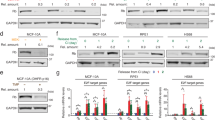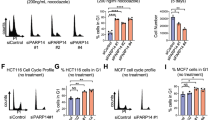Abstract
Phosphorylation of the product of the retinoblastoma susceptibility gene (Rb) physiologically inactivates its growth-suppressive properties. Rb phosphorylation is mediated by cyclin-dependent kinases (CDKs), whose activity is enhanced by cyclins and inhibited by CDK inhibitors. p16INK4A is a member of a family of inhibitors specific for CDK4 and CDK6. p16INK4A is deleted and inactivated in a wide variety of human malignancies, including familial melanomas and pancreatic carcinoma syndromes, indicating that it is an authentic human tumor suppressor. Although one mechanism for its tumor suppression may be prevention of Rb phosphorylation, thereby causing G1 arrest, many normal cell types express p16INK4A, and are still able to traverse the cell cycle. In a search for other mechanisms, we have found that p16INK4A is required for p53-independent G1 arrest in response to DNA-damaging agents, including topoisomerase I and II inhibitors. Thus, like other tumor suppressors, p16INK4A plays an essential role in a DNA-damage checkpoint that leads to cell cycle arrest.
Similar content being viewed by others
References
Sherr, C. J. (1996) Cancer cell cycles. Science 274, 1672–1677.
Paulovich, A. G., Toczyski, D. P. and Hartwell, L. H. (1997) When checkpoints fail. Cell 88, 315–321.
Di Leonardo, A., Linke, S. P., Clarkin, K. and Wahl, G. M. (1994) DNA damage triggers a prolonged p53-dependent G1 arrest and long-term induction of Cip 1 in normal human fibroblasts. Genes Dev. 8, 2540–2551.
Slebos, R. J., Lee, M. H., Plunkett, B. S., Kessis, T. D., Williams, B. O., Jacks, T., Hedrick, L., Kastan, M. B. and Cho, K. R. (1994) p53-dependent G1 arrest involves pRB-related proteins and is disrupted by the human papillomavirus 16 E7 oncoprotein. Proc. Natl. Acad. Sci. USA 91, 5320–5324.
Waldman, T., Kinzler, K. W. and Vogelstein, B. (1995) p21 is necessary for the p53-mediated G1 arrest in human cancer cells. Cancer Res. 55, 5187–5190.
Shapiro, G. I., Edwards, C. D., Ewen, M. E. and Rollins, B. J. (1998) p16INK4A participates in a G1 arrest checkpoint in response to DNA damage. Mol. Cell. Biol. 18, 378–387.
Morgan, D. O. (1995) Principles of CDK regulation. Nature 374, 131–134.
Carnero, A. and Hannon, G. J. (1998) The INK4 family of CDK inhibitors. Curr. Topics Microbiol. Immunol. 227, 43–55.
Xiong, Y., Zhang, H. and Beach, D. (1993) Subunit rearrangement of the cyclin-dependent kinases is associated with cellular transformation. Genes Dev. 7, 1572–1583.
Lukas, J., Parry, D., Aagaard, L., Mann, D. J., Bartkova, J., Strauss, M., Peters, G. and Bartek, J. (1995) Retinoblastoma-protein-dependent cell cycle inhibition by the tumor suppressor p16. Nature 375, 503–506.
Parry, D., Bates, S., Mann, D. J. and Peters, G. (1995) Lack of cyclin D-cdk complexes in Rbnegative cells correlates with high levels of p16INK4/MTS1 tumour suppressor gene product. EMBO J. 14, 503–511.
Serrano, M., Hannon, G. J. and Beach, D. (1993) A new regulatory motif in cell-cycle control causing specific inhibition of cyclin D/CDK4. Nature 366, 704–707.
Russo, A. A., Tong, L., Lee, J. O., Jeffrey, P. D. and Pavletich, N. P. (1998) Structural basis for inhibition of the cyclin-dependent kinase Cdk6 by the tumour suppressor p16INK4a. Nature 395, 237–243.
Medema, R. H., Herrera, R. E., Lam, F. and Weinberg, R. A. (1995) Growth suppression by p16ink4 requires functional retinoblastoma protein. Proc. Natl. Acad. Sci. 92, 6289–6293.
Shapiro, G. I., Park, J. E., Edwards, C. D., Mao, L., Merlo, A., Sidransky, D., Ewen, M. E. and Rollins, B. J. (1995) Multiple mechanisms of p16INK4A inactivation in non-small cell lung cancer cell lines. Cancer Res. 55, 6200–6209.
Koh, J., Enders, G. H., Dynlacht, B. D. and Harlow, E. (1995) Tumor-derived p16 alleles encoding proteins defective in cell-cycle inhibition. Nature 375, 506–510.
Kamb, A., Gruis, N. A., Weaver-Feldhaus, J., Liu, Q., Harshman, K., Tavtigian, S. V., Stocjert, E., Day, R. S. I., Johnson, B. E. and Skolnick, M. H. (1994) A cell cycle regulator potentially involved in genesis of many tumor types. Science 264, 436–440.
Nobori, T., Miurra, K., Wu, D. J., Lois, A., Takabayashi, K. and Carson, D. A. (1994) Deletions of the cyclin-dependent kinase-4 inhibitor gene in multiple human cancers. Nature 368, 753–756.
Otterson, G. A., Kratzke, R. A., Coxon, A., Kim, Y. W. and Kaye, F. J. (1994) Absence of p16INK4 protein is restricted to the subset of lung cancer lines that retains wildtype RB. Oncogene 9, 3375–3378.
Shapiro, G. I., Edwards, C. D., Kobzik, L. Godleski, J., Richards, W., Sugarbaker, D. J., and Rollins, B. J. (1995) Reciprocal Rb inactivation and p16INK4 expression in primary lung cancers and cell lines. Cancer Res. 55, 505–509.
Hirama, T. and Koeffler, H. P. (1995) Role of the cyclin-dependent kinase inhibitors in the development of cancer. Blood 86, 841–854.
Hussussian, C. J., Struewing, J. P., Goldstein, A. M., Higgins, P. A., Ally, D. S., Sheahan, M. D., Clark, W. J., Tucker, M. A. and Dracopoli, N. C. (1994) Germline p16 mutations in familial melanoma. Nature Gene. 8, 15–21.
Goldstein, A. M., Fraser, M. C., Struewing, J. P., Hussussian, C. J., Ranade, K., Zametkin, D. P., Fontaine, L. S., Organic, S. M., Dracopoli, N. C., Clark, W. H. J. and Tucker, M. A. (1995) Increased risk of pancreatic cancer in melanoma-prone kindreds with p16 INK4 mutations. N. Engl. J. Med. 333, 970–974.
Whelan, A. J., Bartsch, D. and Goodfellow, P. J. (1995) Brief report: a familial syndrome of pancreatic cancer and melanoma with a mutation in the CDKN2 tumor-suppressor gene. N. Engl. J. Med. 333, 975–977.
Serrano, M., Lee, H. W., Chin, L., Cordon-Cardo, C., Beach, D. and DePinho, R. A. (1996) role of the INK4a locus in tumor suppression and cell mortality. Cell 85, 27–37.
Gazzeri, S., Goyyer, V., Vour'ch, C., Brambilla, C. and Brambilla, E. (1998) Mechanisms of p16INK4A inactivation in non-small-cell lung cancers. Oncogene 16, 497–504.
Merlo, A., Herman, J. G., Mao, L., Lee, D. J., Gabrielson, E., Burger, P. C., Baylin, S. B. and Sidransky, D. (1995) 5′ CpG island methylation is associated with transcriptional silencing of the tumor suppressor p16/CDKN2/MTS1 in human cancers. Nat. Med. 7, 686–692.
Herman, J. G., Merlo, A., Mao, L., Lapidus, R. G., Issa, J. P., Davidson, N. E., Sidransky, D. and Baylin, S. B. (1995) Inactivation of the CDKN2/p16/MTS1 gene is frequently associated with aberrant DNA methylation in all common human cancers. Cancer Res. 55, 4525–4530.
Mao, L., Merlo, A., Bedi, G., et al. (1995) A novel p16INK4A transcript. Cancer Res. 55, 2995–2997.
Stone, S. S., Jiang, P., Dyananth, P., Tavtigian, S. V., Katcher, H., Parry, D., Peters, G. and Kamb, A. (1995) Complex structure and regulation of the P16 (MTS1) locus. Cancer Res. 55, 2988–2994.
Kamijo, T., Weber, J. D., Zambetti, G., Zindy, F., Roussel, M. F. and Sherr, C. J. (1998) Functional and physical interactions of the ARF tumor suppressor with p53 and Mdm2. Proc. Natl. Acad. Sci. USA 95, 8292–8297.
Zhang, Y., Xiong, Y. and Yarbrough, W. G. (1998) ARF promotes MDM2 degradation and stabilizes p53: ARF-INK4a locus deletion impairs both the Rb and p53 tumor suppression pathways. Cell 92, 725–734.
Pomerantz, J., Schreiber-Agus, N., Liegeois, N. J., et al. (1998) The Ink4a tumor suppressor gene product, p19Arf, interacts with MDM2 and neutralized MDM2′s inhibition of p53. Cell 92, 713–723.
Bates, S., Phillips, A. C., Clark, P. A., Stott, F., Peters, G., Ludwig, R. L. and Vousden, K. H. (1998) p14ARF links the tumour suppressors RB and p53. Nature 395, 124–125.
Tam, S. W., Shay, J. W. and Pagano, M. (1994) Differential expression and cell cycle regulation of the cyclin-dependent kinase 4 inhibitor p16Ink4. Cancer Res. 54, 5816–5820.
Hannon, G. J., Demetrick, D. and Beach, D. (1993) Isolation of the Rb-related p130 through its interaction with CDK2 and cyclins. Genes Dev. 7, 2378–2391.
Hirai, H., Roussel, M. F., Kato, J., Ashmun, R. A. and Sherr, C. J. (1995) Novel INK4 proteins, p18 and p19, are specific inhibitors of cyclin D-dependent kinases CDK4 and CDK6. Mol. Cell. Biol. 15, 2672–2681.
Sandhu, C., Garbe, J., Bhattacharya, N., et al. (1997) Transforming growth factor beta stabilizes p15INK4B protein, increases p15INK4B-cdk4 complexes, and inhibits cyclin D1-cdk4 association in human mammary epithelial cells. Mol. Cell. Biol. 17, 2458–2467.
Herman, J. G., Jen, J., Merlo, A. and Baylin, S. B. (1996) Hypermethylation-associated inactivation indicates a tumor suppressor role for p15 INK4B1. Cancer Res. 56, 722–727.
Sedlacek, H. H., Czech, J., Naik, R., Kaur, G., et al. (1996) Flavopiridol (L868275;NSC 649890), a new kinase inhibitor for tumor therapy. Int. J. Oncol. 9, 1143–1168.
Brusselbach, S., Nettelbeck, D. M., Sedlacek, H. H. and Muller, R. (1998) Cell cycle-independent induction of apoptosis by the anti-tumor drug Flavopiridol in endothelial cells. Int. J. Cancer 77, 146–152.
Shimizu, T., Cao, C. X., Shao, R. G. and Pommier, Y. (1998) Lamin B phosphorylation by protein kinase calpha and proteolysis during apoptosis in human leukemia HL60 cells. J. Biol. Chem. 273, 8669–8674.
Parker, B. W., Kaur, G., Nieves-Neira, W. (1998) Early induction of apoptosis in hematopoietic cell lines after exposure to flavopiridol. Blood 91, 458–465.
Konig, A., Schwartz, G. K., Mohammad, R. M., Al-Katib, A. and Gabrilove, J. L. (1997) The novel cyclin-dependent kinase inhibitor flavopiridol downregulates Bcl-2 and induces growth arrest and apoptosis in chronic B-cell leukemia lines. Blood 90, 4307–4312.
Author information
Authors and Affiliations
Rights and permissions
About this article
Cite this article
Shapiro, G.I., Edwards, C.D. & Rollins, B.J. The physiology of p16INK4A-mediated G1 proliferative arrest. Cell Biochem Biophys 33, 189–197 (2000). https://doi.org/10.1385/CBB:33:2:189
Issue Date:
DOI: https://doi.org/10.1385/CBB:33:2:189




